Before September 11, 2001, the top floors of One World Trade Center were a beehive of broadcast and utility radio activity. There were numerous repeaters, microwave relays, plus analog and new digital television transmitters in operation, feeding plenty of RF to arrays on two titannic masts reaching 1400 feet above the ground. The facilities were well designed, with plenty of back-up power and cooling. Eight television stations using WTC1 for their primary transmitters were: WPIX (analog and digital), WCBS (analog), WNBC (analog and digital), WABC (analog and digital), WNET (digital), WWOR (digital), WPXN and WNJU (both digital, but not yet transmitting). In hindsight, it seems odd that so much broadcast infrastructure would concentrate in one place, but loss of the whole tower was implausible. Loss of both WTC1 and WTC2 was absolutely an unbelievable idea.
Then the unbelievable happened, and except for one station (WWOR) transmitting from the Empire Stste Building, viewers without cable service saw the television band go dead. Viewers with good antennas could aim at other nearby towns and continue watching the dreadful events of 9/11 continue to unfold. Oddly, the satellite signal from WPIX froze on the last video frame received from the relay at WTC 1. A replay was in progress, depicting the two burning towers prior to the collapse of World Trade Center 2. The image remained on the satellite link for hours until it was turned off.
Stations\' initial return to the air was not very well organized. WCBS had a backup transmitter at the Empire State building - a 35 year old Harris transmitter. WPIX is rumored to have aimed an antenna out of a window of the Empire State Building\'s 81st floor. Other stations in the area, in a spirit of cooperation, carrried news programming of their otherwise competitors.
In the immediate days after September 11, stations made arrangements - with FCC approval - to relocate their primary transmitter sites. WABC, WNBC, WPIX, WNET, and WNJU would go to an historic radio tower built on the west bank of the Hudson River, in Alpine, New Jersey. Erected in 1937 for Major Edwin Armstrong's development of his new "Frequency Modulation," the tower stands about 700 feet over area terrain, and has a commanding view of Manhattan. In a way, it represented a reconciliation between sides involved in the birth and adoption of FM broadcasting. Armstrong created a superior technology, but had a falling out with friend David Sarnoff, of what would become NBC. Sarnoff was more interested in developing television and saw little potential in the fidelity and noise resistance of FM. After 9/11, WNBC found a home on Armstrong\'s Alpine Tower.
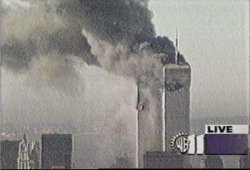
Last WPIX frame before collapse of World Trade Center 1 |
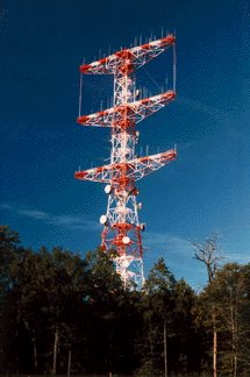
Major Edwin Armstrong\'s Alpine Tower |
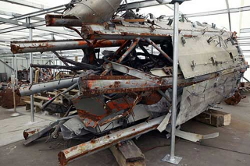
Fragments of the antenna from One World Trade Center |
Television stations were not the only ones to migrate after 9/11. Some FM broadcasters also went to the Alpine tower. Others found that Four Times Square offered better coverage of Manhattan, Queens, and Brooklyn. Still others, including TV stations, sought out classical accomodation at the Empire State Building.
The Empire Stste Building features a very well designed antenna system for multiple FM stations as well as radiators for at least some TV transmitters. WABC, WPIX, and WNET shared an antenna there by November, 2001. WNBC and WCBS eventually moved to the Empire Stste Building by mid 2002, while smartly retaining the Alpine Tower as a backup site safely separated from the primary.
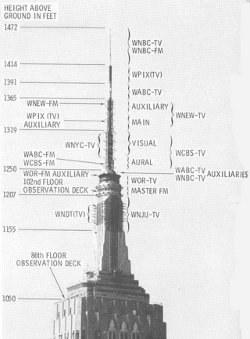
Empire State Building antennas circa 1967. |
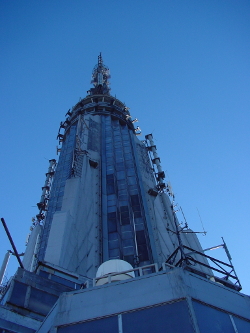
The Empire State Building antennas in 2004 |
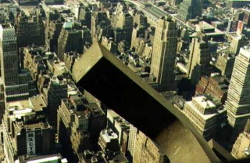
Alford FM antenna element close up. It is a dipole! |
Broadcasters are in need of a transmitter location high enough above the skyscrapers to serve the New York area without gaps and multipath effects. Some consideration is being given to areas in New Jersey abeam lower Manhattan. Governors Island, Bayonne, and even a higher tower in Alpine. These ideas are being met with resistance from residents of increasingly wealthy neighborhoods on the Hudson as well as aviation interests citing hazards to flights passing through Teterboro and Newark airports. In reality, there are three locations in existence that will be available for broadcasters serving New York: the Alpine Tower, Empire State Building, and Four Times Square. None of these are as ideal as the World Trade Center, but they are available now and tomorrow.
In closing, it would be apropriate to remind all that the excellent coverage enjoyed by broadcasters using WTC 1 would not have been possible without the skill and hard work of engineers. They made sure the equipment was properly installed and operated. They kept the signals clean and free of surious emissions. They were ever watchful and made sure nothing stopped the video and sound from going out for all to see. Here is a rememberance of them:
- Donald DiFranco (WABC-TV)
- Steven Jacobson N2SJ (WPIX)
- William Steckman WA2ACW, WNBC TV
- Isaias Rivera (CBS)
- Bob Pattison (WCBS)
- Gerard "Rod" Coppola KA2KET, WNET TV
Also, there were radio amateurs killed at the World Trade Center who were not engineers, but were there for their regular jobs and one Port Authority Policeman on duty.
- Bob Cirri KA2OTD, Port Authority Policeman
- Michael Jacobs AA1GO, Employee at WTC
- Winston Grant KA2DRF, Employee at WTC
- Winston A. Grant, KA2DRF
The TV stations transmitting from One World Trade Center were a favorite long distance TV catch for me in the early 1980s, from Baltimore, MD. Read about my early activities chasing New York TV dx. Where was I during the 9/11 events? On a jetliner that had to turn around and land ASAP! Read about Amtran 751 here
© 2005 - 2025 AB9IL.net, All Rights Reserved.
Written and curated by Philip Collier / AB9IL.
About Philip Collier / AB9IL, Commentaries and Op-Eds, Contact, Privacy Policy and Affiliate Disclosure, XML Sitemap.
This website is reader-supported. As an Amazon affiliate, I earn from qualifying purchases.